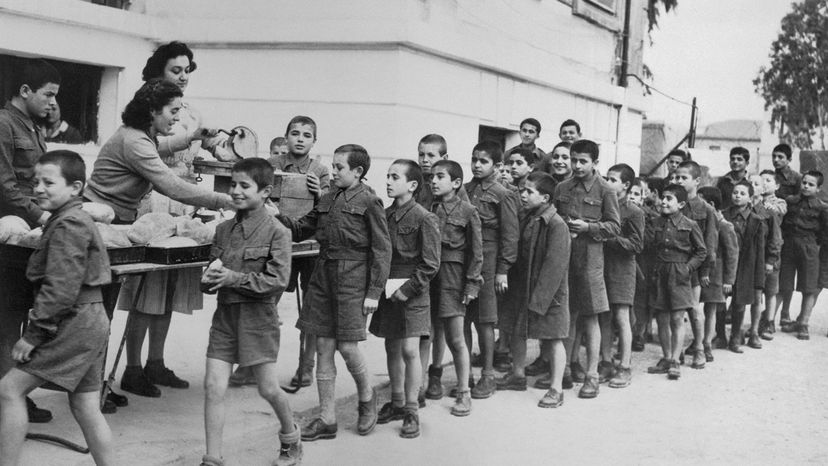Effects of the Marshall Plan

The Marshall Plan didn't happen inside a government-insulated vacuum. While officials hurriedly sketched out their plans for the foreign funding, a vast propaganda campaign also got underway. The participating countries publicly heralded the Marshall Plan as a saving grace with posters, leaflets and other media.
Marshall Plan Political Cartoon
One such booklet distributed by the Ministry of Economic Affairs in the Netherlands contained a cartoon proclaiming "Without the Marshall Plan, your bread would be bare and so would your children," above an image of towheaded children dressed in rags [source: Library of Congress].
Advertisement
The sheer size of the grant demanded the American public's approval as well, and that pro-Marshall Plan message extended into the United States. The May 1948 issue of Kiplinger was devoted to taking advantage of the Marshall Plan's economic ripple effect.
How Did the Marshall Plan Generate Economic Growth?
Certainly, U.S. industries profited from the jolt of exporting to Western Europe. After all, the lifeline wasn't just a pile of cash; it included foodstuffs, agricultural equipment and machinery. This also helped establish the United States as a longstanding trade partner and the global economic powerhouse of the second half of the 20th century.
During the Marshall Plan period, Western Europe's aggregate gross national product jumped by more than 32 percent; agricultural production rose 11 percent above the prewar level, and industrial output increased by a whopping 40 percent [source: Hogan]. This wasn't all due to the Marshall Plan: Local resources accounted for 80-90 percent of the capital formation. But what the Marshall Plan did was to provide support at a critical time.
"It facilitated essential imports, eased production bottlenecks, encouraged higher rates of capital formation, and helped to suppress inflation — all of which led to gains in productivity, to improvements in trade, and to an era of social peace and prosperity more durable than any other in Modern European history," wrote Michael J. Hogan in a 50th anniversary remembrance for the U.S. Diplomatic Mission to Germany.
Soviet Reactions to the Marshall Plan
Not surprisingly, the Soviet Union sat out of the celebratory jig over the Marshall Plan, and historians have since debated whether the plan exacerbated the Cold War tension. The Soviet Union fought back against Marshall Plan propaganda through the Communist Information Bureau, or Cominform. They also introduced a grant package called the Molotov Plan for Eastern bloc nations [source: Schaff]. Ironically, if the Soviet Union had remained involved in the Marshall Plan, the United States would've likely withdrawn its offer for economic support because it wouldn't finance a Communist government [source: Crawley].
Marshall Plan End Date
On Dec. 31, 1951, the Marshall Plan ended six months earlier than originally planned. The Korean War had shifted the U.S. foreign policy focus, and Western Europe was experiencing a wartime manufacturing boom. Two years later, George C. Marshall received the Nobel Prize for spearheading the European Recovery Plan.
The effects of the program have continued in Europe. The postwar years were the first time that Western European countries had worked as closely for mutual gain. That international cooperation demanded by the Marshall Plan laid the groundwork for the formation of the European Union (EU). In an interesting twist of economic fate, today's gross domestic product in the EU and the value of its currency exceeds that of the United States.
Related Articles
More Great Links
Sources
- Crawley, Vince. "Marshall Plan for Rebuilding Europe Still Echoes After 60 Years." Washington File. State Department. May 22, 2007. (Feb. 17, 2009)http://www.america.gov/st/washfile-english/2007/May/20070521163245MVyelwarC7.548159e-02.html
- Crawley, Vince. "Marshall Plan Placed Europe on Path Toward Unity." Washington File. State Department. May 22, 2007. (Feb. 17, 2009)http://www.america.gov/st/washfile-english/2007/May/20070522162259MVyelwarC0.7400019.html
- Crawley, Vince. "Marshall Plan Seen As Model for Well-Run, Short-Lived Program." Washington File. State Department. (Aug. 5, 2020) https://www.academia.edu/36021663/The_Marshall_Plan_Responsible_Actions_For_European_Stability_While_Curbing_Communism
- Hogan, Michael J., "Blueprint for Recovery," U.S. Diplomatic Mission to Germany. Marshall Foundation. (Aug. 5, 2020) https://www.marshallfoundation.org/library/wp-content/uploads/sites/16/2014/05/The_Marshall_Plan_A_Blueprint_for_Recovery.pdf
- Hoover, Herbert. "The President's Economic Mission to Germany and Austria." Feb. 28, 1947. (Feb. 17, 2009)http://www.trumanlibrary.org/whistlestop/study_collections/marshall/large/documents/pdfs/5166.pdf#zoom=100
- Hindley, Meredith. "How the Marshall Plan Came About." Humanities. National Foundation of the Arts and Humanities. November/December 1998. (Aug. 5, 2020) https://www.questia.com/magazine/1P3-38955931/how-the-marshall-plan-came-about
- "Key Dates for the Marshall Plan." Library of Congress. July 11, 2005. (Feb. 17, 2009)http://www.loc.gov/exhibits/marshall/mars.html
- Machado, Barry F. "In Search of a Usable Past: The Marshall Plan and Postwar Reconstruction Today." George C. Marshall Foundation. 2007. (Feb. 17, 2009) https://www.marshallfoundation.org/library/wp-content/uploads/sites/16/2014/05/Chapter_1.pdf
- Marshall, George C. "Marshall Plan." Harvard University. June 5, 1947. (Feb. 17, 2009)http://www.nato.int/docu/speech/1947/s470605a_e.htm
- Schaff, Marta. "The Marshall Plan." Marshall Plan. 2005 (Aug. 5, 2020) http://connection.ebscohost.com/c/articles/17988151/marshall-plan
- Schain, Martin. "The Marshall Plan: Fifty Years After." Macmillan. 2001. (Feb. 17, 2009) https://books.google.com/books?id=ybAQmmyrLN8C&newbks=0&hl=en&source=newbks_fb
- "The Truman Doctrine, 1947." U.S. Department of State. (Feb. 17, 2009)http://www.state.gov/r/pa/ho/time/cwr/82210.htm